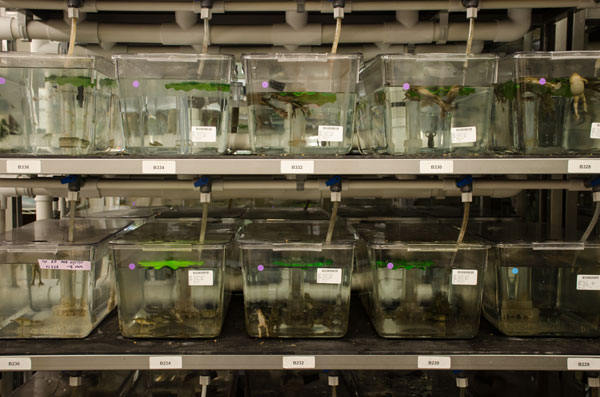Marko Horb Receives Grant to Establish Xenopus Mutant Resource at MBL

The National Xenopus Resource (NXR) at the MBL is as a national stock center for the Xenopus genus of frogs and also serves as a training center for Xenopus researchers to learn advanced technologies, e.g., imaging and genome editing. Established at the MBL in 2010, the NXR is directed by MBL Senior Scientist Marko Horb and is funded by the National Institutes of Health.
Two species of Xenopus (X. laevis and X. tropicalis), in particular, have had a significant impact on multiple domains of biomedical research with numerous studies providing important insights into mechanisms of human development and diseases, including congenital heart disease, diabetes, kidney disease, cancer, and limb development. In 2014, Horb established a research program at the NXR to efficiently apply genome editing technologies, such as CRISPR-Cas9, for generation of Xenopus mutants to model human disease. To date, 117 different mutants have been created at the NXR and this year, Horb received a new grant to expand this effort and develop the “Xenopus Mutant Resource” within the NXR. The National Institutes of Health’s Office of Research Infrastructure Programs provided the funding.
 Frog tanks in the National Xenopus Resource at the MBL.
Frog tanks in the National Xenopus Resource at the MBL.A major goal of the Xenopus Mutant Resource is to generate and characterize new Xenopus mutants in key genes related to human development and disease. By creating these mutant animals, the resource will provide researchers with new tools to interrogate candidate disease gene function and developmental signaling pathways. The Xenopus Mutant Resource will also be a centralized research hub for scientists to come and collaborate while working on many different mutants, as well as obtain training in working with Xenopus tropicalis, the species most amenable to genetic manipulation. X. tropicalis has a shorter history of being used in biomedical research and thus is less familiar to Xenopus researchers. The grant provides support for visiting scientists to come to the MBL year-round and take advantage of all NXR resources. This is especially helpful to the majority of Xenopus researchers who work on X. laevis and are unable to house or do not have X. tropicalis, and for non-Xenopus researchers wishing to pursue experiments in frog.
In addition to generating new Xenopus mutants at the request of researchers, other aims of the funded project include: (1) collaborate with Xenopus researchers to characterize the existing 117 mutants that were developed over the last four years, (2) generate new transgenic lines that will allow for more tissue-specific expression of Cas9, and (3) develop homology-directed repair for more efficient generation of site-specific integration of exogenous DNA. All of these aims will enhance the utilization of CRISPR-Cas gene editing methods in Xenopus.
Horb’s laboratory is part of the MBL’s Eugene Bell Center for Regenerative Biology and Tissue Engineering.